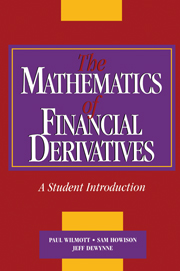Book contents
- Frontmatter
- Contents
- Preface
- Part One Basic Option Theory
- 1 An Introduction to Options and Markets
- 2 Asset Price Random Walks
- 3 The Black–Scholes Model
- 4 Partial Differential Equations
- 5 The Black–Scholes Formulæ
- 6 Variations on the Black–Scholes Model
- 7 American Options
- Part Two Numerical Methods
- Part Three Further Option Theory
- Part Four Interest Rate Derivative Products
- Hints to Selected Exercises
- Bibliography
- Index
3 - The Black–Scholes Model
from Part One - Basic Option Theory
Published online by Cambridge University Press: 05 June 2012
- Frontmatter
- Contents
- Preface
- Part One Basic Option Theory
- 1 An Introduction to Options and Markets
- 2 Asset Price Random Walks
- 3 The Black–Scholes Model
- 4 Partial Differential Equations
- 5 The Black–Scholes Formulæ
- 6 Variations on the Black–Scholes Model
- 7 American Options
- Part Two Numerical Methods
- Part Three Further Option Theory
- Part Four Interest Rate Derivative Products
- Hints to Selected Exercises
- Bibliography
- Index
Summary
Introduction
We begin this chapter with a discussion of the concept of arbitrage, a concept which, in certain circumstances, allows us to establish precise relationships between prices and thence to determine them. We then discuss option strategies in general and use arbitrage, together with the model for asset price movements that we discussed in the previous chapter, to derive the celebrated Black–Scholes differential equation for the price of the simplest options, the so-called European vanilla options. We also discuss the boundary conditions to be satisfied by different types of option, and we set the scene for the derivation of explicit solutions. This chapter is fundam,ental to the whole subject of option pricing and should be read with care.
Arbitrage
One of the fundamental concepts underlying the theory of financial derivative pricing and hedging is that of arbitrage. This can be loosely stated as “there's no such thing as a free lunch.” More formally, in financial terms, there are never any opportunities to make an instantaneous risk-free profit. (More correctly, such opportunities cannot exist for a significant length of time before prices move to eliminate them.) The financial application of this principle leads to some elegant modelling.
Almost all finance theory, this book included, assumes the existence of risk-free investments that give a guaranteed return with no chance of default. A good approximation to such an investment is a government bond or a deposit in a sound bank.
- Type
- Chapter
- Information
- The Mathematics of Financial DerivativesA Student Introduction, pp. 33 - 57Publisher: Cambridge University PressPrint publication year: 1995



